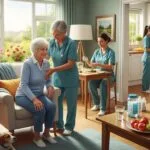The American Medical Association has created a funding opportunity for changes to medical education that reflect the needs of future patients, providers and students (see AMA press release). Exciting stuff for those who have been watching and waiting for adoption of new educational technologies, mlearning, MOOCs and more to catch fire in medical education! Specifically, the AMA has pledged funding be awarded to medical schools that:
The American Medical Association has created a funding opportunity for changes to medical education that reflect the needs of future patients, providers and students (see AMA press release). Exciting stuff for those who have been watching and waiting for adoption of new educational technologies, mlearning, MOOCs and more to catch fire in medical education! Specifically, the AMA has pledged funding be awarded to medical schools that:
- Develop new methods for teaching and/or assessing key competencies for medical students and fostering methods to create more flexible, individualized learning plans.
- Promote exemplary methods to achieve patient safety, performance improvement and patient-centered team based care, and improving understanding of the health care system and health care financing in medical training.
- Enhance development of professionalism throughout the medical education learning environment.
Can medical schools of the future really embrace a new culture of learning (see ETY post A New Culture of Learning by John Seeley Brown), or a learning environment that looks like this (see ETY post Medical School and Classrooms of the Future):
Having just returned from a week visiting the good folks at Virginia Mason Medical Center (VMMC) in Seattle, WA, a group of us listened as VMMC associates broke down the benefits of using their Virginia Mason Production System (VMPS), which is essentially the Toyota Production System, or Lean methodology with a touch of Boeing’s expertise thrown in, and then adapted to their own healthcare environment. The skill sets involved to execute Lean effectively are taught at some B-Schools, but definitely not medical school as a rule, and while applied with restraint and awareness of the ripple effect when changing complex systems, can have real benefits to the financial health of a healthcare system. But those who had graduated through different levels of the VMPS training, shared how the first year was a blur as they studied the concepts, and learned the language of Kaizen and going to the Gemba. How the VMPS intentionally and consistently improves patient safety for the long haul remains a little unclear, leaving additional training and educational voids addressing a just culture, care for the caregiver, full disclosure, shared decision-making, patient-centered care and engagement…the list goes on.
Some additional food for thought:
- What if a proven cost-savings and quality improvement method for major manufacturers was taught universally to care providers as the scaffolding by which they plan-do-study-act?
- What if human factors engineering and the science of safety were taught in every medical school across the country, as well as an understanding of what it means to be a high risk organization, but still be a highly reliable organization?
- How do you fit all this on top of a basic science and clinical curriculum?
- And this is just innovation to the curriculum. Now how do you deliver the education in a way that engages students versus having the one drawing the short straw at happy hour show up to take notes during lecture the next day?
- And what about pharmacy, nursing and allied health curriculums? How will we connect all care providers, as caring for patients in teams becomes the new gold standard?
To develop a 4-year medical school curriculum that includes a working knowledge of all these topics is most likely not humanly possible to complete, but if the culture of healthcare business was defined, instead of recreated at every institution across the country, perhaps young students and residents would enter into their new positions with some of the guess work removed from the mix. What if multi-disciplinary teams were already in place, care for the caregiver programs the norm, unsafe condition-near miss-and-incident reporting celebrated, rules, regulations, respect and joy in their work environments were all givens at every hospital across the country? This same guess work not only has a direct impact on job satisfaction, but also on patient care. I’m just throwing ideas out as a starting place in hopes that those much more qualified will join this conversation! Time is of the essence too–in the AMA’s January 17th press release, they share that:
…Across the continuum of medical education, the gap between how physicians are trained and the future needs of health care continues to widen…
Originally posted on Educate the Young
![]()






_9-250x220.jpg.webp)

